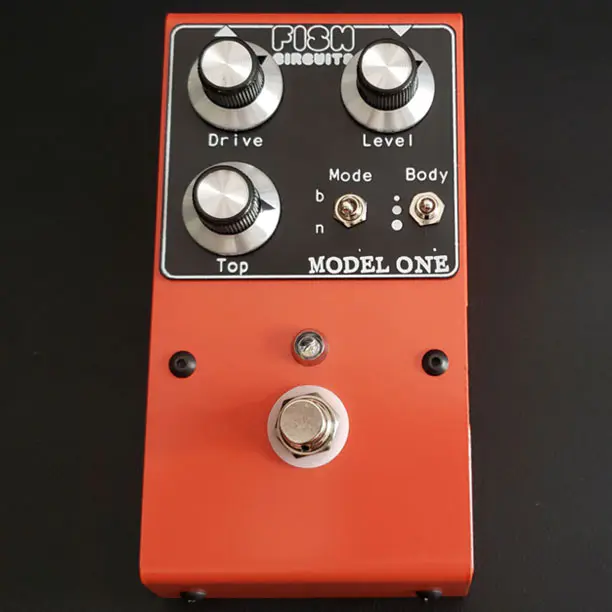
Our homie (as in Montreal-based) Mike Poisson has recently launched the first pedal from his new company, the Fish Circuits Model One, an overdrive featuring an original circuit.
Hosted in a vintage-looking, custom trapezoidal case, this is a drive that can do more than one thing, and do it well: at lower gain settings it delivers dynamic and touch-sensitive amp-like breakup tones, while when cranked up it can concoct a wide range of saturated tones, from tasty to thick, up to distortion and borderline fuzz, with loads of sustain and depth.
Besides your usual Drive and Level knobs, and a Top knob that acts as tone, the Model One features two switches:
The two-way Mode toggle lets you select between two different gain structures. Mode “n” has a lot more volume than “b” but less gain, delivering a classic low-gain sound, while “b,” with a lot more gain but less volume, offers a saggier and more distorted tone, bordering on fuzz at high Gain settings.
The Body switch gives you three low-frequency levels at the input stage, which at fatter levels will generate extra harmonics when the distortion is active. The top position cuts most of the bass out.
Fish Circuits Model One, Buider’s Notes
Classic natural overdrive with spicy tweaks. Incredibly versatile and more than usable on just about any settings. At lower gain settings, the MODEL ONE will give you dynamic amp-like breakup tones, that react to the subtleties of your playing. When cranked, you will find yourself in a saturated « fuzzstortion » territory, with loads of sustain and depth, reminiscent of citrus-colored amps.
“Drive” is the gain control. It sounds like a scratchy pot when you turn it, this is normal.
“Mode” switch lets you select between the classic lower gain sound and “b” mode that showcases the saggier and more distorted side of the design, with almost fuzz-like tones when the “Drive” control is maxed out. “n” mode has a lot more volume output than “b” and “b” mode has a lot more gain than “n”. Expect a volume drop on “b” mode.
“Body” switch controls the amount of lower frequencies at the input stage of the pedal. The lowest setting is the fattest, for the biggest and meanest sound… it might even be too much. The lower position being sometimes more low end than you actually need in a band mix, the middle position comes in handy, tidying things up. The bass cut being at the input of the circuit (before the gain stages), you will still get a rich full sound when distorted, but with less mud. The top position cuts most of the bass out, because that might be what you need in a busier mix, or for layering guitar tracks.
The Model One runs on just about any 9V DC, negative tip, 2.1mm barrel power supply. Cheap power supplies tend to induce noise.






















